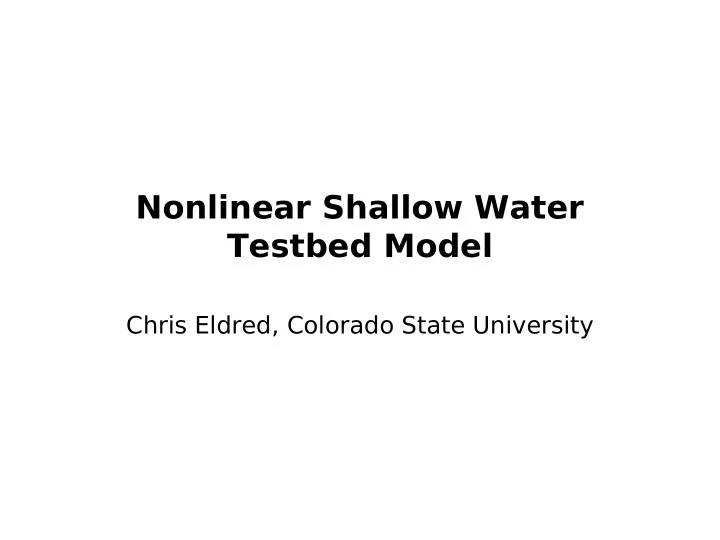

Nonlinear Shallow Water Testbed Model Chris Eldred, Colorado State University
A) Project Overview Subset of the Global Circulation Model development being done at the Center for Multiscale Modeling of Atmospheric Processes (CMMAP) Global cloud resolving model based on a system of equations that filters vertically propagating sound waves. The vorticity and divergence are predicted, and the model is implemented on a geodesic grid. CSU Team Members: David Randall, Celal Konor, Ross Heikes, Don Dazlich, many others We have had SciDAC support since 2000. Ario Arakawa was involved until the current grant. My funding comes from the DOE Computational Science Fellowship Going to restrict myself to what I am working on
B) Science Lesson • Nonlinear Shallow Water Testbed Model (NTM) – Has two components: Shallow Water Model and Eigensolver – Shallow Water Model • Solves the nonlinear shallow water equations on an f-plane (soon to be beta-plane and sphere as well) • Variety of different schemes implemented (all finite- volume/finite-difference) • Variety of different variable staggerings implemented (A,C,Z,Z*) • Variety of different grids implemented (planar square, hexagon, triangle) under a generic Voronoi mesh framework – Eigensolver • Determines the eigenstructure of the linear shallow water equations for a given grid and variable staggering • Important for understanding the effects of discretization on waves in the atmosphere
C) Parallel Programming Model + Computational Methods Written in Fortran 90 with Cheetah as a templating language (code-autogeneration, controlled with cfg files) Fortran namelists used to control run-time behavior Uses PETSC and SLEPC for: – Parallel vector management (decomposition, indexing, etc.) – Linear solver (Poisson problem, associed with vorticity- divergence formulation) – Sparse eigenvalue solver (SLEPC) • Python is used as an analysis and visualization system – Uses Numpy, Scipy and Matplotlib – Scripts written to parse output (text right now, soon to be CF-compliant NetCDF) and generate plots and reports • Would like scalability out to ~1000 cores (past that not useful) • Currently only tested on my workstation
E) I/O Patterns and Strategy • Right now write 1 file per MPI process – Python scripts put it back together • Need to explore pNetCDF, probably using specific MPI I/O processes to overlap I/O and computation • No input files (other than namelist) • Output size is controlled by size of grid and number of variables used by the scheme, typically <1GB for the grids I have been testing • No checkpoint/restart capabilities right now – Would like to put this in later
F) Visualization and Analysis • How do you explore the data generated? – Python scripts produce plots and generate reports – Plotting is automated based on the variables defined by the scheme – Generic Voronoi mesh plotting code written on top of Matplotlib • Do you have a visualization workflow? – 1 script does everything at this point • Would like to use a cfg file to control what is plotted/analyzed and how • Plans to incorporate movies of field evolution
G/I) Performance and Scaling • Haven't had an issue with speed using workstation for test cases (small though) • Unsure of performance/scaling bottlenecks • PETSC has proven scalability well beyond what I need – Just need to make sure my code doesn't slow it down • Need to start profiling (Tau?) • This is something I haven't really explored yet • Would like to be scalable out to ~1000 cores in the next year
H) Tools • Debugging: – Gdb for single-core stuff – Combo of gdb and print statements for parallel stuff • Need a better debugging solution here • Other tools – Use makefiles for compilation – Uses Cheetah (python templating engine) to auto-generate code based on scheme/variable configuration • Plans to move project to GitHub or Google Code and use Git for code management and bug-tracking
J) Roadmap • Primary: need to finish parallelization of shallow water model and eigensolver • Long-Term: Want to have shallow water model and eigensolver fully implemented for scalable, 1000 core performance in the next year • Would like to add cubed-sphere grids and finite element-type methods (spectral element, discontinuous Galerkin) • NTM should be a useful framework for testing and evaluating different schemes and grids for the non- linear shallow water equations
Recommend
More recommend